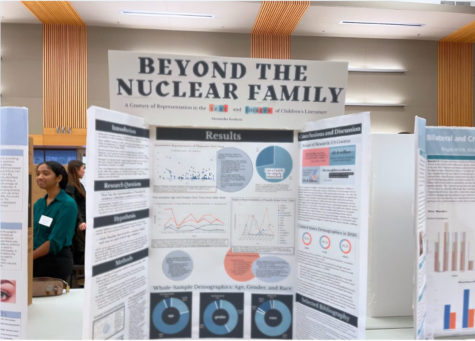Your donation will support the student journalists of West Linn High School. Your contribution will allow us to continue to produce quality content by purchasing equipment, software, and continuing to host our website on School Newspapers Online (SNO).
Beyond the nuclear family
April 21, 2023
Diversity portrayed in modern-day media is continuously expanding and changing. Annamika Konkola, sophomore, began exploring possible ISEF projects in the summer of 2022.
Konkola researched the change in diversity represented within families in best selling American children’s books within the past century, from 1922— 2022. To do this, Konkola used a word and image analysis of around 2,460 pages worth of content from 75 best seller books.
“My hypothesis was that increasingly diverse families would be featured,” Konkola said. “There ended up being few statistically significant differences over time, which indicates that there hasn’t been as much change.”

The results of this project show that the families that were portrayed in best seller children’s books remained to be mostly white, nuclear families. Konkola created a way to systemically point out and look at the gaps that are within children’s, specifically the range from kindergarten to second grade, literature. Her research included analyzing the changes in family representation using both artificial intelligence and human coding. Human coding allowed the analysis of the children’s book to be more efficient, rather than looking through each book with the human eye. However, other skills such as statistics were utilized in her research.
“It was just a lot of organization in coordinating, and then statistics,” Konkola said. “I had no background in statistics before this, so it was definitely challenging to figure out what kind of tests we would run to get data.”
Though learning new concepts can be difficult, these subjects can be applicable to real life situations. Konkola hopes to apply her project to create a change and benefit society from her findings.
“Presenting these findings to elementary school teachers and maybe comparing how libraries of teachers in different school districts, compared to these best selling books in terms of metrics of representation would be really interesting,” Konkola said.
Konkola mainly contacted Danielle Schroeder, an ISEF coordinator, to get the resources needed for the experiment. Support and encouragement for an ISEF project is administered by the coordinators, providing different ways to access certain people, labs, etc. Other contacts outside of the school district can be utilized as well.
“I was able to talk to professors in social science, and one about child development, I think she was studying about research that was similar to the kinds of questions that I was asking,” Konkola said. “I was able to get a really good grasp about this super weirdly specific niche of social science research.”
ISEF is not only a project that takes time and research outside of the classroom. Currently, students who partake in an ISEF project, regardless of where it places in the district competition, can receive half of a science credit. Next year, ISEF is expected to become a year-long class.
“It’s just a really good opportunity,” Konkola said. “I’m so glad that I have had this opportunity this year. It made me realize that the topics that I’m interested in, like sociology and social science, definitely do have a connection to science and statistics.”